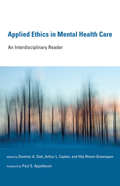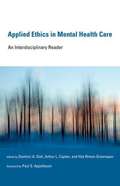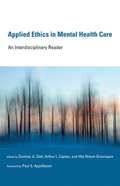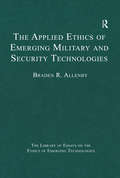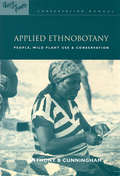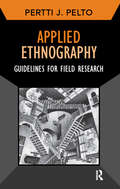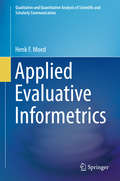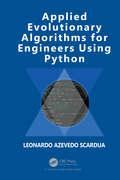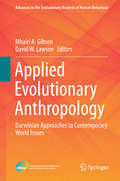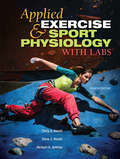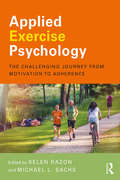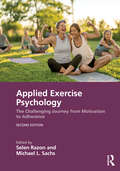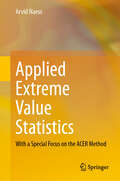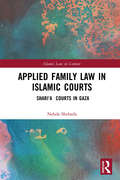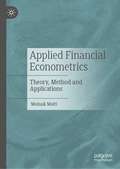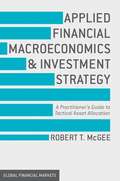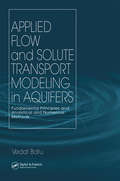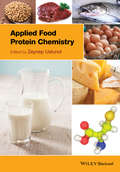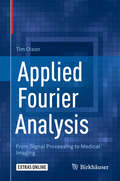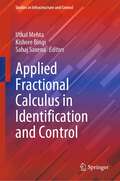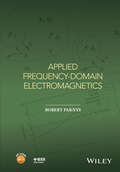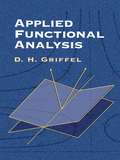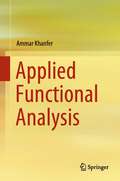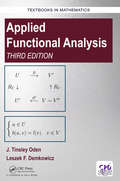- Table View
- List View
Applied Ethics in Mental Health Care: An Interdisciplinary Reader (Basic Bioethics)
by Dominic A. Sisti Artur L. Caplan Hila Rimon-GreenspanDiscussions of key ethical dilemmas in mental health care, including consent, trauma and violence, addiction, confidentiality, and therapeutic boundaries.This book discusses some of the most critical ethical issues in mental health care today, including the moral dimensions of addiction, patient autonomy and compulsory treatment, privacy and confidentiality, and the definition of mental illness itself. Although debates over these issues are ongoing, there are few comprehensive resources for addressing such dilemmas in the practice of psychology, psychiatry, social work, and other behavioral and mental health care professions. This book meets that need, providing foundational background for undergraduate, graduate, and professional courses.Topics include central questions such as evolving views of the morality and pathology of deviant behavior; patient competence and the decision to refuse treatment; recognizing and treating people who have suffered trauma; addiction as illness; the therapist's responsibility to report dangerousness despite patient confidentiality; and boundaries for the therapist's interaction with patients outside of therapy, whether in the form of tennis games, gift-giving, or social media contact. For the most part the selections address contemporary issues in contemporary terms, but the book also offers a few historic or classic essays, including Thomas S. Szasz's controversial 1971 article “The Ethics of Addiction.”ContributorsLaura Weiss Roberts, Frederic G. Reamer, Charles P. O'Brien, and Thomas McLellan
Applied Ethics in Mental Health Care: An Interdisciplinary Reader
by Dominic A. Sisti Artur L. Caplan Hila Rimon-GreenspanThis book discusses some of the most critical ethical issues in mental health caretoday, including the moral dimensions of addiction, patient autonomy and compulsory treatment,privacy and confidentiality, and the definition of mental illness itself. Although debates overthese issues are ongoing, there are few comprehensive resources for addressing such dilemmas in thepractice of psychology, psychiatry, social work, and other behavioral and mental health careprofessions. This book meets that need, providing foundational background for undergraduate,graduate, and professional courses. Topics include central questions such asevolving views of the morality and pathology of deviant behavior; patient competence and thedecision to refuse treatment; recognizing and treating people who have suffered trauma; addiction asillness; the therapist's responsibility to report dangerousness despite patient confidentiality; andboundaries for the therapist's interaction with patients outside of therapy, whether in the form oftennis games, gift-giving, or social media contact. For the most part the selections addresscontemporary issues in contemporary terms, but the book also offers a few historic or classicessays, including Thomas S. Szasz's controversial 1971 article "The Ethics of Addiction. "Contributors include Laura Weiss Roberts, Frederic G. Reamer, Charles P. O'Brien, and ThomasMcLellan.
Applied Ethics in Mental Health Care: An Interdisciplinary Reader
by Dominic A. Sisti Artur L. Caplan Hila Rimon-GreenspanThis book discusses some of the most critical ethical issues in mental health caretoday, including the moral dimensions of addiction, patient autonomy and compulsory treatment,privacy and confidentiality, and the definition of mental illness itself. Although debates overthese issues are ongoing, there are few comprehensive resources for addressing such dilemmas in thepractice of psychology, psychiatry, social work, and other behavioral and mental health careprofessions. This book meets that need, providing foundational background for undergraduate,graduate, and professional courses. Topics include central questions such asevolving views of the morality and pathology of deviant behavior; patient competence and thedecision to refuse treatment; recognizing and treating people who have suffered trauma; addiction asillness; the therapist's responsibility to report dangerousness despite patient confidentiality; andboundaries for the therapist's interaction with patients outside of therapy, whether in the form oftennis games, gift-giving, or social media contact. For the most part the selections addresscontemporary issues in contemporary terms, but the book also offers a few historic or classicessays, including Thomas S. Szasz's controversial 1971 article "The Ethics of Addiction. "Contributors include Laura Weiss Roberts, Frederic G. Reamer, Charles P. O'Brien, and ThomasMcLellan.
The Applied Ethics of Emerging Military and Security Technologies (The Library of Essays on the Ethics of Emerging Technologies)
by Braden R. AllenbyThe essays in this volume illustrate the difficult real world ethical questions and issues arising from accelerating technological change in the military and security domains, and place those challenges in the context of rapidly shifting geopolitical and strategic frameworks. Specific technologies such as autonomous robotic systems, unmanned aerial vehicles, cybersecurity and cyberconflict, and biotechnology are highlighted, but the essays are chosen so that the broader implications of fundamental systemic change are identified and addressed. Additionally, an important consideration with many of these technologies is that even if they are initially designed and intended for military or security applications, they inevitably spread to civil society, where their application may raise very different ethical questions around such core values as privacy, security from criminal behaviour, and state police power. Accordingly, this volume is of interest to students of military or security domains, as well as to those interested in technology and society, and the philosophy of technology.
Applied Ethnobotany: People, Wild Plant Use and Conservation (People and Plants International Conservation)
by Anthony B CunninghamIts wise and sensitive approach to working with local people will be relevant in situations throughout the world.' ECOS 'The numerous diagrams, tables of data, information flow charts, fieldwork sketches etc. give a great vibrancy to the work... It deserves a wide readership.' TEG News Wild or non-cultivated plants are crucial to the lives of a large portion of the world's population, providing low-cost building materials, fuel, food supplements, medicines, tools and sources of income. Despite their importance, their vulnerability to harvesting and other social impacts is not well understood. Applied Ethnobotany is the first practical guide to be published on how to manage wild plant species sustainably. This detailed manual on wild plant resources sets out the approaches and field methods involved in participatory work between conservationists, researchers and the primary resource users. Supported by extensive illustrations, it explains how local people can learn to assess the pressures on plant resources and what steps to take to ensure their continued availability. For all those involved in resource management decisions regarding plant species and diversity, and in particular those studying or working in conservation, rural development and park management, this guide is invaluable. Published with WWF, UNESCO and Royal Botanic Gardens Kew
Applied Ethnography: Guidelines for Field Research (Developing Qualitative Inquiry #12)
by Pertti J PeltoThis comprehensive, engaging guide to applied research distills the expertise of the distinguished ethnographer and methodologist Pertti Pelto over his acclaimed 50-year career. Having written the first major text promoting mixed qualitative and quantitative methods in applied ethnography in the 1970s, Pelto now synthesizes decades of innovation, including examples from around the world that illustrate how specific methods yield immediate results for addressing social problems. Ideal for researchers, students, training programs, and technical assistance projects, this thorough text covers the key topics and skills required: gaining entry, recording and organizing field data, a host of specialized techniques, integrating qualitative and quantitative methods, building and training research teams, rapid assessment and focused ethnographic studies, short- and long-term ethnography, writing up results, non-Western perspectives on research, and more.
Applied Evaluative Informetrics (Qualitative and Quantitative Analysis of Scientific and Scholarly Communication)
by Henk F. MoedThis book focuses on applied evaluative informetric artifacts or topics. It explains the base notions and assumptions of evaluative informetrics by discussing a series of important applications. The structure of the book is therefore not organized by methodological characteristics, but is centered around popular, often discussed or used informetric artifacts - indicators, methodologies, products, databases - or so called hot topics in which informetric indicators play an important role. Most of the artifacts and topics emerged during the past decade. The principal aims of the book is to present a state of the art in applied evaluative informetrics, and to inform the readers about the pros and cons, potentialities and limitations of the use of informetric/bibliometric indicators in research assessment. The book is a continuation of the book Citation Analysis in Research Evaluation (Springer, 2005). It is of interest to non-specialists, especially research students at advanced master level and higher, all those subjected to quantitative research assessment, research managers and other users of applied informetric techniques, and interested scholars from all domains of science and scholarship.
Applied Evolutionary Algorithms for Engineers using Python
by Leonardo Azevedo ScarduaApplied Evolutionary Algorithms for Engineers with Python is written for students, scientists and engineers who need to apply evolutionary algorithms to practical optimization problems. The presentation of the theoretical background is complemented with didactical Python implementations of evolutionary algorithms that researchers have recently applied to complex optimization problems. Cases of successful application of evolutionary algorithms to real-world like optimization problems are presented, together with source code that allows the reader to gain insight into the idiosyncrasies of the practical application of evolutionary algorithms. Key Features Includes detailed descriptions of evolutionary algorithm paradigms Provides didactic implementations of the algorithms in Python, a programming language that has been widely adopted by the AI community Discusses the application of evolutionary algorithms to real-world optimization problems Presents successful cases of the application of evolutionary algorithms to complex optimization problems, with auxiliary source code.
Applied Evolutionary Anthropology: Darwinian Approaches to Contemporary World Issues (Advances in the Evolutionary Analysis of Human Behaviour #1)
by Mhairi A. Gibson David W. LawsonAs a species, we are currently experiencing dramatic shifts in our lifestyle, family structure, health, and global contact. Evolutionary Anthropology provides a powerful theoretical framework to study such changes, revealing how current environments and legacies of past selection shape human diversity. This book is the first major review of the emerging field of Applied Evolutionary Anthropology bringing together the work of an international group of evolutionary scientists, addressing many of the major public health and social issues of this century. Through a series of case studies that span both rural and urban situations in Africa, Asia, Europe and South America, each chapter addresses topics such as natural resource management, health service delivery, population growth and the emergence of new family structures, dietary, and co-operative behaviours. The research presented identifies the great, largely untapped, potential that Applied Evolutionary Anthropology holds to guide the design, implementation and evaluation of effective social and public health policy. This book will be of interest to policy-makers and applied researchers, along with academics and students across the biological and social sciences.
Applied Exercise and Sport Physiology, With Labs: With Labs
by Dona J. Housh Terry J. Housh Herbert A. DevriesApplied Exercise & Sport Physiology, Fourth Edition, presents theory and application in an appealing, balanced, and manageable format. By providing an essential introduction to the systems of the human body and covering important aspects of exercise and sport physiology, it will be a useful resource for students as they learn to become exercise science professionals, physician's assistants, physical therapists, physical educators, or coaches. It provides the right amount of practical information they will need to apply in hospitals, clinics, schools, and settings such as health clubs, youth sport leagues, and similar environments. The authors have carefully designed the material to be covered easily in one semester, in an introductory course, but the book can also serve as a foundation for advanced courses. Its 18 lab experiences are matched to relevant chapters and complement the topics covered; they allow readers to apply physiological principles to exercise and sport, provide opportunities for hands-on learning and application of the scientific principles, and often don't require complex equipment.
Applied Exercise Psychology: The Challenging Journey from Motivation to Adherence
by Selen Razon Michael L. SachsApplied Exercise Psychology emphasizes the application of evidence-based knowledge drawn from the fields of exercise psychology, health psychology, clinical and counseling psychology, and exercise physiology for physical activity behavior change. The book provides readers with: theoretical bases for understanding and promoting physical activity behavior; interventions to use for facilitating physical activity behavior change and the tools for measuring the effectiveness of these interventions; cross-cultural considerations for practitioners to ensure multicultural competency; considerations to guide best practices with special populations (e.g., persons with medical conditions and persons with mental health conditions); overall applied implications and future directions. The collection builds a bridge between up-to-date research findings, relevant field experiences, and applied implications. This is the first book to cover such breadth of topics in applied exercise psychology, with chapters bringing often overlooked issues to the attention of practitioners to promote not only evidence-based practice but also responsible ethics and referral.
Applied Exercise Psychology: The Challenging Journey from Motivation to Adherence
by Selen Razon Michael L. SachsNow in its second edition, Applied Exercise Psychology emphasizes the application of evidence-based knowledge drawn from the fields of exercise psychology, health psychology, clinical and counseling psychology, and exercise physiology for physical activity behavior change. Thoroughly revised, the new edition offers readers: two new chapters covering Excusercise and Mood Alteration’s link to exercise; fully updated sections on current research and theoretical bases for understanding and promoting physical activity behavior; interventions for facilitating physical activity behavior change and the tools for measuring the effectiveness of these interventions; cross-cultural considerations for practitioners to ensure multicultural competency; considerations to guide best practices with special populations (e.g., persons with medical conditions and persons with mental health conditions); overall applied implications and future directions. An essential read that covers a variety of critical topics in applied exercise psychology, it brings often overlooked issues to the attention of practitioners to promote not only evidence-based practice but also responsible ethics and referral. The collection is a key reference for up-to-date research findings, relevant field experiences, and applied implications.
Applied Extreme Value Statistics: With a Special Focus on the ACER Method
by Arvid NaessThis book does not focus solely on asymptotic extreme value distributions. In addition to the traditional asymptotic methods, it introduces a data-driven, computer-based method, which provides insights into the exact extreme value distribution inherent in the data, and which avoids asymptotics. It therefore differs from currently available texts on extreme value statistics in one very important aspect. The method described provides a unique tool for diagnostics, and for efficient and accurate extreme value prediction based on measured or simulated data. It also has straightforward extensions to multivariate extreme value distributions. The first half provides an introduction to extreme value statistics with an emphasis on applications. It includes chapters on classical asymptotic theories and threshold exceedance models, with many illustrative examples. The mathematical level is elementary and, to increase readability, detailed mathematical proofs have been avoided in favour of heuristic arguments. The second half presents in some detail specialized topics that illustrate the power and the limitations of the concepts discussed. With diverse applications to science, engineering and finance, the techniques described in this book will be useful to readers from many different backgrounds.
Applied Family Law in Islamic Courts: Shari’a Courts in Gaza (Islamic Law in Context)
by Nahda ShehadaWritten from an ethnographic perspective, this book investigates the socio-legal aspects of Islamic jurisprudence in Gaza-Palestine. It examines the way judges, lawyers and litigants operate with respect to the law and with each other, particularly given their different positions in the power structure within the court and within society at large. The book aims at elucidating ambivalences in the codified statutes that allow the actors to find practical solutions to their (often) legally unresolved problems and to manipulate the law. The book demonstrates that present-day judges are not only confronted with novel questions they have to find an answer to, but, perhaps more importantly, they are confronted with contradictions between the letter of codified law and their own notions of justice. The author reminds us that these notions of justice should not be set a priori; they are socially constructed in particular time and space. Making a substantial contribution to a number of theoretical debates on family law and gender, the book will appeal to both academic and non-academic readers alike.
Applied Financial Econometrics: Theory, Method and Applications
by Moinak MaitiThis textbook gives students an approachable, down to earth resource for the study of financial econometrics. While the subject can be intimidating, primarily due to the mathematics and modelling involved, it is rewarding for students of finance and can be taught and learned in a straightforward way. This book, going from basics to high level concepts, offers knowledge of econometrics that is intended to be used with confidence in the real world. This book will be beneficial for both students and tutors who are associated with econometrics subjects at any level.
Applied Financial Macroeconomics and Investment Strategy
by Robert T. McgeeThe absolute and relative performance of various asset classes is systematically related to macroeconomic trends. In this new book, Robert McGee provides a thorough guide to each stage of the business cycle and analyzes the investment implications using real-world examples linking economic dynamics to investment results.
Applied Finite Mathematics
by Rupinder SekhonThis module contains all 10 chapters of the Applied Finite Mathematics open textbook by Rupinder Sekhon.
Applied Flow and Solute Transport Modeling in Aquifers: Fundamental Principles and Analytical and Numerical Methods
by Vedat BatuOver recent years, important contributions on the topic of solving various aquifer problems have been presented in numerous papers and reports. The scattered and wide-ranging nature of this information has made finding solutions and best practices difficult. Comprehensive and self-contained, Applied Flow and Solute Transport Modeling in Aquifers co
Applied Food Protein Chemistry
by Zeynep UstunolFood proteins are of great interest, not only because of their nutritional importance and their functionality in foods, but also for their detrimental effects. Although proteins from milk, meats (including fish and poultry), eggs, cereals, legumes, and oilseeds have been the traditional sources of protein in the human diet, potentially any proteins from a biological source could serve as a food protein. The primary role of protein in the diet is to provide the building materials for the synthesis of muscle and other tissues, and they play a critical role in many biological processes. They are also responsible for food texture, color, and flavor. Today, food proteins are extracted, modified, and incorporated into processed foods to impart specific functional properties. They can also have adverse effects in the diet: proteins, such as walnuts, pecans, almonds, and cashews, soybean, wheat, milk, egg, crustacean, and fish proteins can be powerful allergens for some people.Applied Food Protein Chemistry is an applied reference which reviews the properties of food proteins and provides in-depth information on important plant and animal proteins consumed around the world. The book is grouped into three sections: (1) overview of food proteins, (2) plant proteins, and (3) animal proteins. Each chapter discusses world production, distribution, utilization, physicochemical properties, and the functional properties of each protein, as well as its food applications. The authors for each of the chapters are carefully selected experts in the field. This book will be a valuable reference tool for those who work on food proteins. It will also be an important text on applied food protein chemistry for upper-level students and graduate students of food science programs.
Applied Fourier Analysis: From Signal Processing To Medical Imaging
by Tim OlsonThe first of its kind, this focused textbook serves as a self-contained resource for teaching from scratch the fundamental mathematics of Fourier analysis and illustrating some of its most current, interesting applications, including medical imaging and radar processing. Developed by the author from extensive classroom teaching experience, it provides a breadth of theory that allows students to appreciate the utility of the subject, but at as accessible a depth as possible. With myriad applications included, this book can be adapted to a one or two semester course in Fourier Analysis or serve as the basis for independent study. Applied Fourier Analysis assumes no prior knowledge of analysis from its readers, and begins by making the transition from linear algebra to functional analysis. It goes on to cover basic Fourier series and Fourier transforms before delving into applications in sampling and interpolation theory, digital communications, radar processing, medi cal imaging, and heat and wave equations. For all applications, ample practice exercises are given throughout, with collections of more in-depth problems built up into exploratory chapter projects. Illuminating videos are available on Springer. com and Link. Springer. com that present animated visualizations of several concepts. The content of the book itself is limited to what students will need to deal with in these fields, and avoids spending undue time studying proofs or building toward more abstract concepts. The book is perhaps best suited for courses aimed at upper division undergraduates and early graduates in mathematics, electrical engineering, mechanical engineering, computer science, physics, and other natural sciences, but in general it is a highly valuable resource for introducing a broad range of students to Fourier analysis.
Applied Fractional Calculus in Identification and Control (Studies in Infrastructure and Control)
by Utkal Mehta Kishore Bingi Sahaj SaxenaThe book investigates the fractional calculus-based approaches and their benefits to adopting in complex real-time areas. Another objective is to provide initial solutions for new areas where fractional theory has yet to verify the expertise. The book focuses on the latest scientific interest and illustrates the basic idea of general fractional calculus with MATLAB codes. This book is ideal for researchers working on fractional calculus theory both in simulation and hardware. Researchers from academia and industry working or starting research in applied fractional calculus methods will find the book most useful. The scope of this book covers most of the theoretical and practical studies on linear and nonlinear systems using fractional-order integro-differential operators.
Applied Frequency-Domain Electromagnetics
by Robert PaknysUnderstanding electromagnetic wave theory is pivotal in the design of antennas, microwave circuits, radars, and imaging systems. Researchers behind technology advances in these and other areas need to understand both the classical theory of electromagnetics as well as modern and emerging techniques of solving Maxwell's equations. To this end, the book provides a graduate-level treatment of selected analytical and computational methods. The analytical methods include the separation of variables, perturbation theory, Green's functions, geometrical optics, the geometrical theory of diffraction, physical optics, and the physical theory of diffraction. The numerical techniques include mode matching, the method of moments, and the finite element method. The analytical methods provide physical insights that are valuable in the design process and the invention of new devices. The numerical methods are more capable of treating general and complex structures. Together, they form a basis for modern electromagnetic design. The level of presentation allows the reader to immediately begin applying the methods to some problems of moderate complexity. It also provides explanations of the underlying theories so that their capabilities and limitations can be understood.
Applied Functional Analysis (Dover Books on Mathematics)
by D. H. GriffelA stimulating introductory text, this volume examines many important applications of functional analysis to mechanics, fluid mechanics, diffusive growth, and approximation. Detailed enough to impart a thorough understanding, the text is also sufficiently straightforward for those unfamiliar with abstract analysis. Its four-part treatment begins with distribution theory and discussions of Green's functions. Essentially independent of the preceding material, the second and third parts deal with Banach spaces, Hilbert space, spectral theory, and variational techniques. The final part outlines the ideas behind Frechet calculus, stability and bifurcation theory, and Sobolev spaces. 1985 edition. 25 Figures. 9 Appendices. Supplementary Problems. Indexes.
Applied Functional Analysis
by Ammar KhanferThis textbook offers a concise and thorough introduction to the topic of applied functional analysis. Targeted to graduate students of mathematics, it presents standard topics in a self-contained and accessible manner. Featuring approximately 300 problems sets to aid in understanding the content, this text serves as an ideal resource for independent study or as a textbook for classroom use. With its comprehensive coverage and reader-friendly approach, it is equally beneficial for both students and teachers seeking a detailed and in-depth understanding of the subject matter.
Applied Functional Analysis (Textbooks in Mathematics)
by J. Tinsley Oden Leszek DemkowiczApplied Functional Analysis, Third Edition provides a solid mathematical foundation for the subject. It motivates students to study functional analysis by providing many contemporary applications and examples drawn from mechanics and science. This well-received textbook starts with a thorough introduction to modern mathematics before continuing with detailed coverage of linear algebra, Lebesque measure and integration theory, plus topology with metric spaces. The final two chapters provides readers with an in-depth look at the theory of Banach and Hilbert spaces before concluding with a brief introduction to Spectral Theory. The Third Edition is more accessible and promotes interest and motivation among students to prepare them for studying the mathematical aspects of numerical analysis and the mathematical theory of finite elements.
